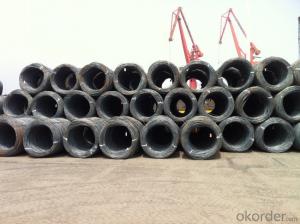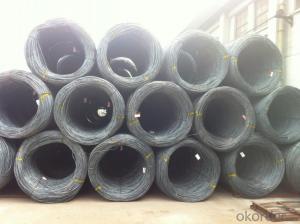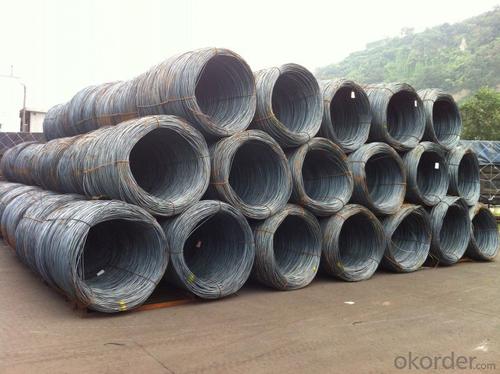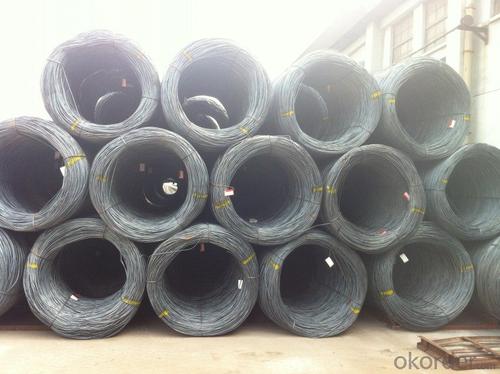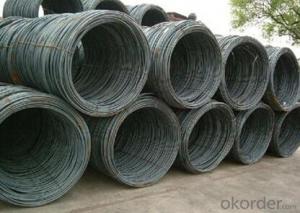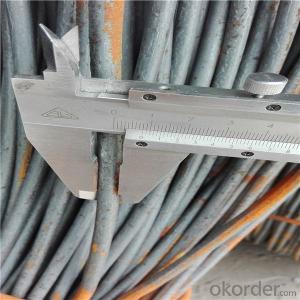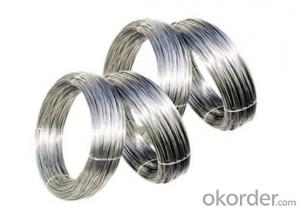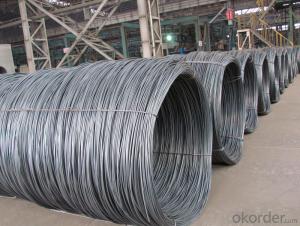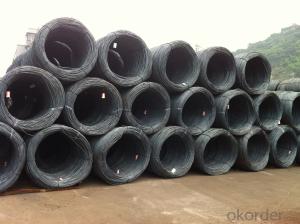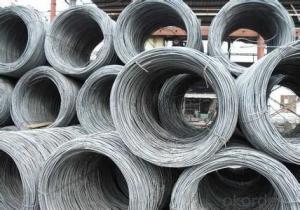Hot Rolled Wire Rods with Material Grade SAE 1008
- Loading Port:
- Tianjin
- Payment Terms:
- TT OR LC
- Min Order Qty:
- 25 m.t.
- Supply Capability:
- 10000 m.t./month
OKorder Service Pledge
OKorder Financial Service
You Might Also Like
Product Description:
OKorder is offering Carbon Steel Wire Rod at great prices with worldwide shipping. Our supplier is a world-class manufacturer of steel, with our products utilized the world over. OKorder annually supplies products to European, North American and Asian markets. We provide quotations within 24 hours of receiving an inquiry and guarantee competitive prices.
Product Applications:
Carbon Steel Wire Rod are ideal for structural applications and are widely used in the construction of buildings and bridges, and the manufacturing, petrochemical, and transportation industries.After hot-rolled the products shaped into coil and delivery as finished product, including round, square, rectangular, hexagonal and so on. Since most of the products are round, it is generally called wire rod. Carbon steel wire rod is widely used in construction and manufacturing. Carbon steel wire rod is mainly used for reinforcement of reinforced concrete and welded structure or reprocessed (roberts , nail, etc.) materials, especially used to produce wire drawing, welding electrode, nails, spring, electronic, precise machinery parts and so on.
Product Advantages:
OKorder's Carbon Steel Wire Rod are durable, strong, and resist corrosion.
Main Product Features:
· Premium quality
· Prompt delivery & seaworthy packing (30 days after receiving deposit)
· Corrosion resistance
· Can be recycled and reused
· Mill test certification
· Professional Service
· Competitive pricing
Product Specifications:
Chemical Composition:
Please kindly find our chemistry of our material based on SAE1006/SAE1008 as below for your information
Grade | Chemical Composition (%) | |||||
C | Mn | S | P | Si | B | |
SAE1006B | 0.03~O.07 | 0.32max | 0.045max | 0.040max | 0.30max | 0.0008min |
Mechanical properties | ||||||
Yield strength(N/mm2) | Tensile strength(N/mm2) | Elongation (%) | ||||
250-280 | 350-380 | ≥32 | ||||
Grade | Chemical Composition (%) | |||||
C | Mn | S | P | Si | B | |
SAE1008B | 0.10max | 0.3~0.50 | 0.050max | 0.040 max | 0.15max | 0.0008 min |
Mechanical properties | ||||||
Yield strength(N/mm2) | Tensile strength(N/mm2) | Elongation (%) | ||||
≥195 | 315-430 | ≥30 | ||||
FAQ:
Q1: Why buy Materials & Equipment from OKorder.com?
A1: All products offered byOKorder.com are carefully selected from China's most reliable manufacturing enterprises. Through its ISO certifications, OKorder.com adheres to the highest standards and a commitment to supply chain safety and customer satisfaction.
Q2: How do we guarantee the quality of our products?
A2: We have established an advanced quality management system which conducts strict quality tests at every step, from raw materials to the final product. At the same time, we provide extensive follow-up service assurances as required.
Q3: How soon can we receive the product after purchase?
A3: Within three days of placing an order, we will begin production. The specific shipping date is dependent upon international and government factors, but is typically 7 to 10 workdays.
Image
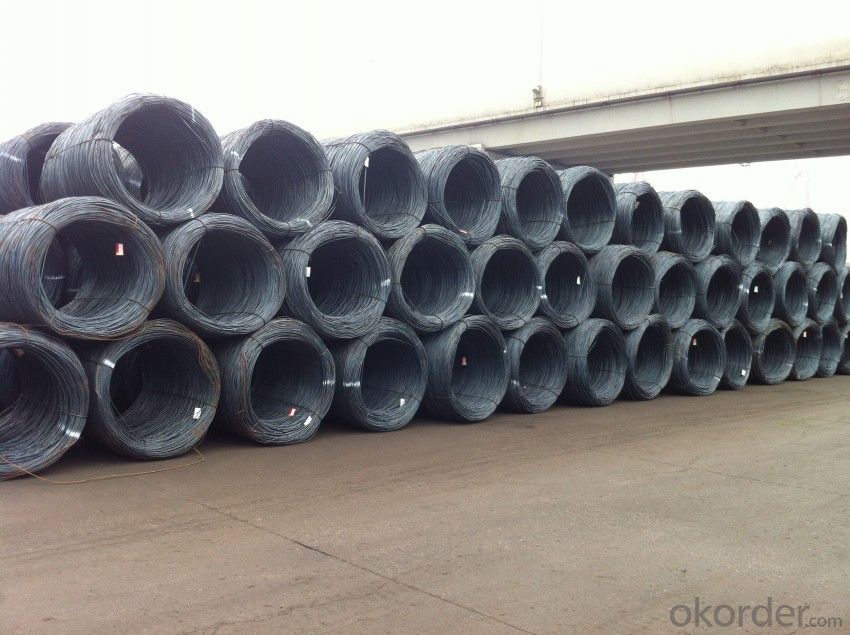
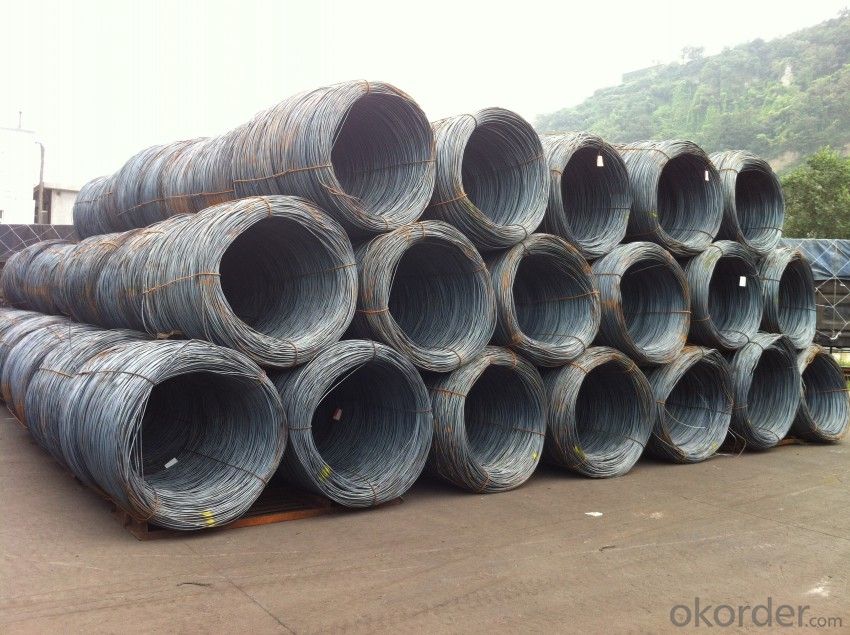
- Q: What is the maximum allowable deviation in diameter for steel wire rod?
- The maximum allowable deviation in diameter for steel wire rod depends on the specific standards and specifications set by different industries and applications. However, in general, the maximum allowable deviation in diameter for steel wire rod is typically specified as a percentage or a specific tolerance range. For example, in the steel industry, the maximum allowable deviation in diameter for steel wire rod can range from +/- 0.010 inches to +/- 0.020 inches, depending on the specific grade and intended use of the wire rod. This means that the diameter of the wire rod can be slightly larger or smaller than its specified value within this tolerance range. It is important to note that these tolerances may vary depending on the specific industry requirements and the intended application of the steel wire rod. Therefore, it is essential to consult the relevant standards, specifications, and guidelines provided by the industry or application to determine the maximum allowable deviation in diameter for steel wire rod in a particular context.
- Q: What are the different types of finishes available for steel wire rod?
- Steel wire rod offers a variety of finishes, each with its own purpose and unique qualities. 1. A bright finish is the most common option, achieved by removing scale or rust from the rod's surface, resulting in a smooth and shiny appearance. It is ideal for applications where aesthetics matter, such as decorative purposes or consumer-facing products. 2. Galvanized finishes involve applying a protective zinc coating to the rod's surface. This provides excellent corrosion resistance, making it suitable for outdoor environments or areas with high moisture. It also offers some level of abrasion resistance, making it suitable for certain industrial applications. 3. Phosphate finishes involve a chemical process that creates a thin phosphate coating on the rod's surface. This enhances the adhesion of lubricants or coatings, making it valuable in applications where lubrication or corrosion resistance is crucial. Industries like automotive and manufacturing commonly use phosphate finishes. 4. Coated finishes involve applying various materials to the steel wire rod to provide specific properties. For instance, epoxy coatings offer excellent corrosion resistance and are used in marine or chemical environments. Polymer coatings can provide abrasion resistance, electrical insulation, or improved adhesion properties. Coated finishes are tailored to meet specific application requirements. 5. Black oxide finishes, or blackening, convert the surface layer of the steel wire rod into a black iron oxide compound. This offers mild corrosion resistance and enhances the wire's appearance. It is commonly used in architectural or decorative products where a black or darkened finish is desired. 6. Zinc-nickel finishes combine zinc and nickel plating, offering higher corrosion resistance than traditional galvanized finishes. They find common use in industries like automotive and aerospace, where strong corrosion resistance is essential. These examples showcase the range of finishes available for steel wire rod. The choice of finish depends on the intended application and the desired properties, such as corrosion resistance, abrasion resistance, or aesthetics.
- Q: Can steel wire rod be used for cold drawing applications?
- Yes, steel wire rod can be used for cold drawing applications. Cold drawing is a process in which a metal rod, such as steel wire rod, is pulled through a die to reduce its diameter and increase its length. This process helps to improve the mechanical properties and surface finish of the wire rod. Steel wire rods are commonly used in cold drawing applications due to their excellent strength and ductility. The high tensile strength of steel allows it to withstand the forces applied during the cold drawing process without breaking or deforming. Additionally, the ductility of steel enables it to be easily elongated without fracturing, making it an ideal material for cold drawing. During the cold drawing process, the steel wire rod is first cleaned and lubricated to reduce friction and prevent surface damage. It is then pulled through a series of dies, which progressively reduce the diameter of the rod. This results in a wire with a smaller diameter and increased length. The cold drawing process provides several benefits to the steel wire rod. It improves the mechanical properties of the wire, such as increasing its tensile strength and hardness. It also enhances the surface finish of the wire, making it smoother and more uniform. Additionally, cold drawing can improve the dimensional accuracy and tolerance of the wire. Steel wire rods are widely used in various industries for cold drawing applications. They are commonly used to produce high-quality wires for applications such as cables, springs, fasteners, and reinforcement materials. The cold drawing process allows manufacturers to customize the diameter, length, and properties of the wire according to their specific requirements. In conclusion, steel wire rod can be successfully used for cold drawing applications. The combination of its high strength and ductility makes it an ideal material for the cold drawing process, resulting in wires with improved mechanical properties and surface finish.
- Q: How is steel wire rod used in the manufacturing of wire fences?
- Steel wire rod is used in the manufacturing of wire fences as it serves as the primary raw material. It is first drawn through a series of dies to achieve the desired thickness and strength. This wire rod is then further processed and coated, if necessary, to enhance its durability and resistance to corrosion. The resulting wire is then woven, welded, or twisted to form the intricate mesh pattern of the wire fence. Overall, steel wire rod plays a crucial role in providing the strength and structural integrity necessary for wire fences to effectively secure and protect various properties.
- Q: How is the brittleness of steel wire rod determined?
- The brittleness of steel wire rod is typically determined by conducting a series of mechanical tests, such as the Charpy impact test or the tensile test. These tests help measure the amount of force or energy required to fracture or break the steel wire rod, providing an indication of its brittleness. Additionally, microscopic examination techniques, like optical microscopy or scanning electron microscopy, can be used to analyze the internal structure of the steel wire rod and identify any signs of brittleness, such as the presence of cracks or grain boundaries.
- Q: What are the different types of steel wire rod finishes for improved chemical resistance?
- There are several types of steel wire rod finishes that can improve chemical resistance. These include galvanized finishes, which involve coating the wire rod with a layer of zinc to protect it from corrosion caused by chemicals. Another option is stainless steel finishes, where the wire rod is made from a stainless steel alloy that is highly resistant to chemical corrosion. Additionally, there are epoxy-coated finishes, where a layer of epoxy resin is applied to the wire rod to provide an extra barrier against chemical contact.
- Q: How is the straightness of steel wire rod measured?
- The straightness of steel wire rod is typically measured using a method called the straightness deviation test. This involves placing the rod on a flat surface and measuring the maximum distance between the rod and the surface at various points along its length. To perform the test, a straightedge or a precision straightness measuring instrument is placed on the surface parallel to the steel wire rod. Several measurements are taken along the length of the rod, typically at regular intervals. The distance between the rod and the straightedge is measured at each point, and the maximum deviation is recorded as the straightness deviation. The straightness deviation is usually expressed in terms of the maximum distance in millimeters or inches that the rod deviates from a perfectly straight line. A smaller deviation indicates a straighter rod, while a larger deviation indicates a more bent or curved rod. In addition to the straightness deviation test, other methods such as visual inspection or laser technology can also be used to assess the straightness of steel wire rod. These methods provide a more detailed and accurate measurement of the rod's straightness, allowing manufacturers to ensure that the rod meets the required quality standards for its intended application.
- Q: What are the different types of steel wire rod packaging options after wire drawing?
- There are several types of steel wire rod packaging options after wire drawing, including spools, coils, reels, and bundles. Each packaging option offers different advantages and is used based on factors such as wire diameter, length, and intended application. Spools are commonly used for small diameter wires and offer easy handling and storage. Coils are used for larger diameter wires and provide efficient transportation and unwinding. Reels are used for heavy-duty applications and provide maximum protection during storage and shipping. Bundles are used for longer lengths of wire and offer convenient handling, storage, and transportation. Overall, the choice of packaging depends on the specific requirements and preferences of the wire manufacturer and end-user.
- Q: How is steel wire rod used in the production of wire baskets?
- Steel wire rod is used in the production of wire baskets as it serves as the primary material for creating the basket's structure. The wire rod is first shaped and welded to form the basket's frame, providing the necessary strength and durability. Additionally, the steel wire rod can be further processed to create the mesh or grid pattern that forms the sides and base of the basket, allowing for the containment and organization of various items.
- Q: What are the common applications of low alloy and oil tempered steel wire rod?
- Low alloy and oil tempered steel wire rod have a wide range of common applications in various industries. One common application is in the manufacturing of automotive components. Low alloy and oil tempered steel wire rod is used to make springs, such as suspension springs and valve springs, which are crucial for the proper functioning of vehicles. The high strength and durability of these steel wire rods make them ideal for withstanding the demanding conditions and heavy loads experienced by automobiles. Another common application is in the construction industry. Low alloy and oil tempered steel wire rod is used to make reinforcing bars (rebars), which are essential for reinforcing concrete structures like buildings, bridges, and highways. The strength and ductility of these steel wire rods ensure that the reinforced structures can withstand the stresses and pressures they are subjected to, providing stability and longevity. In addition, low alloy and oil tempered steel wire rod is also used in the manufacturing of various industrial equipment and machinery. These steel wire rods are commonly used to make wire ropes, which are used in cranes, elevators, and other lifting equipment. The high tensile strength and resistance to corrosion of these steel wire rods make them suitable for withstanding heavy loads and harsh environments. Furthermore, low alloy and oil tempered steel wire rod finds applications in the production of wire mesh, fencing, and other wire products. The strength and durability of these steel wire rods ensure that the wire products can withstand external forces and provide security or containment in various settings, such as construction sites, agricultural fields, and industrial facilities. Overall, the common applications of low alloy and oil tempered steel wire rod include automotive components, construction reinforcement, industrial equipment, and wire products. The unique properties of these steel wire rods, such as high strength, durability, and resistance to corrosion, make them versatile materials that contribute to the functionality and reliability of various products and structures.
Send your message to us
Hot Rolled Wire Rods with Material Grade SAE 1008
- Loading Port:
- Tianjin
- Payment Terms:
- TT OR LC
- Min Order Qty:
- 25 m.t.
- Supply Capability:
- 10000 m.t./month
OKorder Service Pledge
OKorder Financial Service
Similar products
Hot products
Hot Searches
Related keywords

